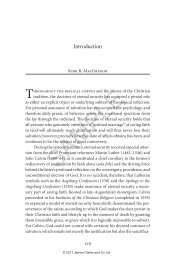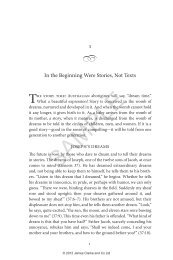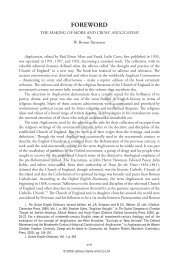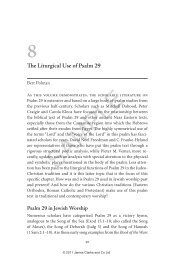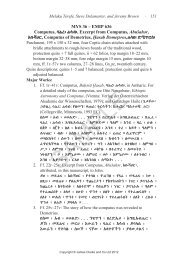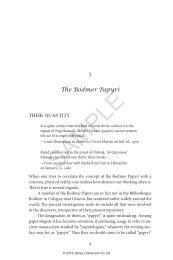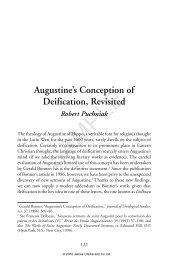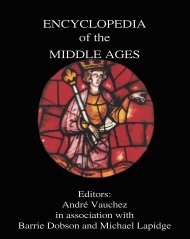Extract from Chapter 1 - James Clarke and Co Ltd
Extract from Chapter 1 - James Clarke and Co Ltd
Extract from Chapter 1 - James Clarke and Co Ltd
You also want an ePaper? Increase the reach of your titles
YUMPU automatically turns print PDFs into web optimized ePapers that Google loves.
The Textual Words of the Analects <strong>and</strong> the Letter to the Galatians<br />
57<br />
the Great Learning (Daxue). 6 They became unified texts only in the Sung<br />
dynasty (960–1279 CE). They are considered classical (jing) texts (wen)<br />
because they have long been regarded as containing a comprehensive underst<strong>and</strong>ing<br />
of the moral, philosophical, <strong>and</strong> political worlds of human<br />
endeavor. The Analects has special place because it collects the teachings<br />
of China’s greatest master, <strong>Co</strong>nfucius. Later commentators have found in<br />
the Analects the essence of the Sage’s teaching <strong>and</strong> the master key to the<br />
classics as a whole. 7<br />
The composition of the Analects began soon after <strong>Co</strong>nfucius’ death<br />
(in 479 BCE) by his disciples <strong>and</strong> successors for the next two centuries<br />
(probably before 220 BCE). By the time of the Han dynasty (206<br />
BCE–200 CE), there were three versions of the Analects (according to<br />
Hanshu, History of the Han Dynasty), <strong>and</strong> the received text (the Lunyu,<br />
which we have today) is made up of these three versions, edited first by<br />
He Yan (190–249 CE). The Analects is a record of the Master’s teaching<br />
as preserved by his earliest disciples with material added by different<br />
<strong>Co</strong>nfucian sects, sometimes of the same mind, sometimes of a competing<br />
spirit. Each composer or editor had his own intention in the editing<br />
process. 8 The present form of the Analects (containing 15,935 words altogether)<br />
is comprised of twenty books (or sections, sometimes referred<br />
to as chapters). Each book is divided into divisions (or paragraphs, <strong>and</strong><br />
sometimes referred to as chapters, about five hundred in all) of individual<br />
6. See Legge <strong>and</strong> Yang, trans., The Four Books.<br />
7. According to the prominent Qing historian of the classics, Chen Li (1810–1882),<br />
“the essentials of classical studies are all in the Analects” (Henderson, Scripture, Canon,<br />
<strong>and</strong> <strong>Co</strong>mmentary, 18). Liu Fenglu remarked that “the Analects sums up the great meanings<br />
of the Six Classics (Henderson, Scripture, Canon, <strong>and</strong> <strong>Co</strong>mmentary, 19). The Analects<br />
was considered a classic by Jesuit missionaries in China <strong>and</strong> Japan during the sixteenth<br />
through eighteenth centuries. Protestant missionaries in the nineteenth century were<br />
also attracted to it; <strong>James</strong> Legge translated the classics into English. Among the best<br />
English translations of the Analects are those by <strong>James</strong> Legge, Arthur Waley, D. C. Lau,<br />
Roger T. Ames <strong>and</strong> Henry Rosemont Jr., Chichung Huang, <strong>and</strong> Edward Slingerl<strong>and</strong>. The<br />
four Chinese commentaries on the Analects I use are: He <strong>and</strong> Xing, Lunyu Zhushu; Yang,<br />
Lunyu Yizhu; Qian, Lunyu Xinjie; Chen, Lunyu Duxun Jiegu; <strong>and</strong> Zhu ed., Sishu.<br />
An excellent online resource on <strong>Co</strong>nfucianism is: http://www.confucius2000.com/.<br />
8. On the technical study of the redaction of the Analects, see Norden ed., <strong>Co</strong>nfucius<br />
<strong>and</strong> the Analects, 14–18; Waley, The Analects of <strong>Co</strong>nfucius, 21–26. Following Waley,<br />
Norden sees Books 3–9 as the earliest portion, with explicit topics, yet Book 10 is irrelevant<br />
<strong>and</strong> Book 1–2 without explicit topics. Brooks <strong>and</strong> Brooks, The Original Analects,<br />
propose the accretion theory. They see only Book 4 is the original <strong>and</strong> dated 479 BCE,<br />
right after the death of <strong>Co</strong>nfucius, <strong>and</strong> the last book (20) was dated 249 BCE.<br />
SAMPLE<br />
© 2008 <strong>James</strong> <strong>Clarke</strong> <strong>and</strong> <strong>Co</strong> <strong>Ltd</strong>





